



Featured image: “Binoculars” at CHB in Berlin (2013)
Varvara Guljajeva & Mar Canet have been working together as an artist duo since 2009. They have exhibited their art pieces in a number of international shows and festivals. As an artist duo they locate thermselves in the fields of art and technology, and are interested in new forms of art and innovation, which includes the application of knitting digital fabrication. They use and challenge technology in order to explore novel concepts in art and design. Hence, research is an integral part of their creative practice. In addition to kinetic and interactive installations, the artists have also experience with working in public spaces and with urban media.
Varvara is originally from Estonia, and gained her bachelor degree in IT from Estonian IT College, and a masters degree in digital media from ISNM in Germany and currently is a PhD candidate at the Estonian Art Academy in the department of Art and Design. Mar (born in Barcelona) has two degrees: in art and design from ESDI in Barcelona and in computer game development from University Central Lancashire in UK. He is also a co-founder of Derivart and Lummo.
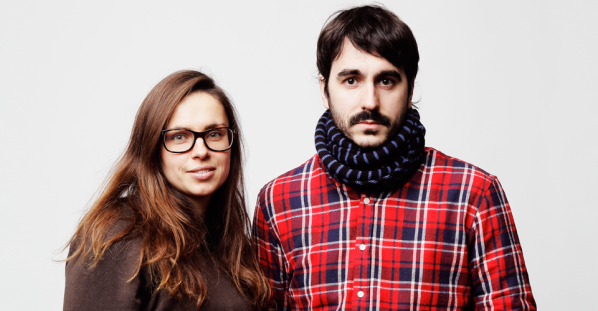
Filippo Lorenzin: Open culture is one of the main points of your research and activity. Could you describe how this influences your art practice?
Varvara & Mar: We are living in very exciting times. Open source has introduced democratization of production and creation. Now you can build your own 3D printer, laser cutter, knitting machine, make a light dimmer circuit or develop a body tracking system. Some years ago we couldn’t even imagine this and now we have access to this knowledge. People share their creations and these process, which is incredibly inspiring for us and many more people. Thus, knowledge is built on top of knowledge. We make use of open source marterial in our work and we try also to contribute back. This is the whole point of open source in our mind. And if one looks in the perspective of art to open source projects, then really many open source projects have artists on board, for example, OpenFrameworks, Processing, and more.
Open source also has an educational aspec. We do many workshops with people and teach what we know and how we work. We think open source culture is largely based on the spirit being open to sharing knowledge with many others.
FL: I’m really fascinated by your interest in textile fabrication. it reminds me the early industrial developments that were deeply connected to in the textiles industry. How and why would knitting be integrated these days as part of a makers’ culture?

V&M: The process of integration is well under way. There has been a good number of makerspaces who have dedicated areas for textile production, like WeMake in Milan and STPLN in Malmö. And believe it or not this simple thing helps to introduce gender balance in these kind of places. We’re not just talking about innovation, which can boost gender equality when you introduce knitting to hacking. We’re also talking about the democratisation of production, when thinking about clothing too. This area is quite vital and commonly understood. 3D printing toys is a cool activity for a weekend, but then it becomes boring. Knitting a sweater or a scarf has real value and the quality is always higher than a typical mass produced factory product.
For 3D printing we cannot say the same. Don’t get us wrong, we are not against the 3D printing. We love it and have six printers in our studio. Our point is that the areas of concern for digital fabrication are not complete, and the founders of FabLab have overlooked the whole area of textiles.
FL: You’ve run many workshops taking in account various topics such as 3D printing, solar energy and knitting, of course. How do these activities connect with your research?
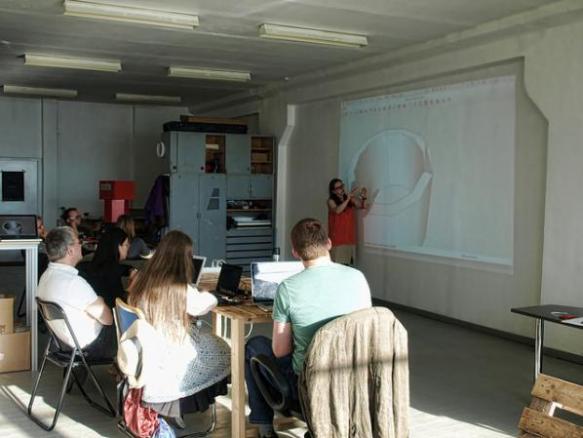
V&M: First of all, we like to teach and interact with our students. Second, preparing a workshop, allows us to research more about the field, and organise and share our accumulated knowledge and experience.
And finally, workshops are one part of our income. We don’t have any other jobs on the side, and exhibitions and commissions are not regular and do not always pay well, and yet the bills keep coming in. Hence, workshops help us to pay our bills.
FL: One of your works which most fascinate me is “Sonima” (2010). It’s a project that takes in account questions that have become quite recurrent in last months, mostly linked to Anthropocene discussions. The soft coexistence of technology and nature which is organic and artifical. Which is one of the main topics of your research: why are you so interested in this question? It looks like you’re trying to develop experiments for an utopistic future in which humans and nature live in symbiosis. Am I wrong?
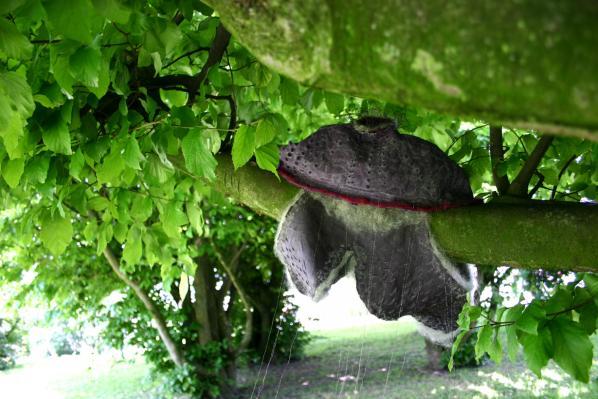
V&M: Yes, many of our works express our futuristic thoughts or imagination where the digital age will lead us and our planet to. It is nice that you have noticed this. I would say this kind of concept in 2010 was quite subconscious. I (Varvara) was very interested in organic form but with mutational origins but still adapted by nature.
More conscious approach towards anthropocene epoch can be seen and felt in “Tree of Hands” (2015), which is one of our recent works. However, it looks like we have touched quite a taboo topic. For instance, “Tree of Hands” was rejected by jury of PAD London fair because of its depressive concept.
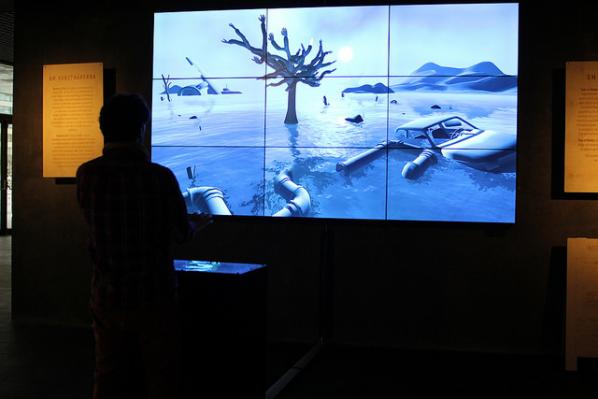
FL: “Shopping in 1 Minute” (2011) is another project I would like to ask you about. This work is about consumerism at its finest (or worst), turning one of the most typical capitalistic places (supermarkets) into ludic spaces. It’s a piece of social art that presents itself without informing the public what is right and what is wrong, but it rather suggests in a more subtle way the perversion at the base of that system. What do you think?
V&M: Yes. What we are doing is the absurd exaggeration of the same action (buying) to a maximum with one but: not buying and playing instead. There is a saying that shopping is 5 min happiness. The artwork tries to create a synthetic feeling of satisfaction of the ability to buy. The shopping centers are doing everything to stimulate our consumption needs, and our artwork manages to get inside their ecosystem and playfully releases that artificial desire to buy.
FL: With at least a couple of projects, you’ve also worked to the redefine hurban landscapes by looking at the invisble while at the same time taking on rather specific forces such as mass use of Wi-Fi networks becoming part of the everyday. I can’t help thinking that this is somehow related to privacy questions, probably because one of the most notorious scandals some years ago was Google’s secret recording of Wi-Fi networks with their Street View cars. Am I wrong?
V&M: Not really. But definitely Google has played a role in feeing our concerns about being watched, spied, hacked, scanned, etc. For example, the last scan for WiFi router names we did last summer in Tallinn some people were quite freaked out seeing a person on a bike with a camera on its head and tablet in front. I was even once asked if I worked for Google. 🙂 Anyways, the project was great fun for us, and we got to explore the city and discover the whole invisible communications networks and the self expressive layers of it all. After the Tallinn scan we even changed our minds about the 32-character local Twitter that the WiFi router SSID could be used for. The Tallinn experience showed us the new tendency: where people would use radio waves for semi-anonymous graffiti, communicating sometimes silly, protective, racist or political messages.
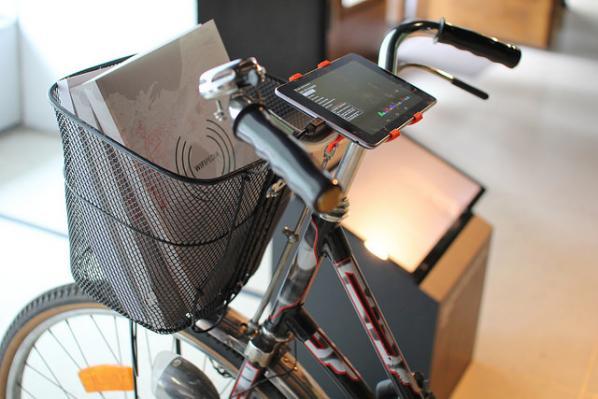
Talking about inspiration for this project, we got our interest for WiFi names from one article talking about the ability to track down pro- and contra-Obama communities by just looking at WiFi names in the neighborhood. This was before the US president election. Then we started to thinking of an art project on this topic.
FL: “The Rythm of City” (2011) is another project which is also ‘subtly’ related to control issues. The idea that someone can depict the state of a city by looking at data deducted from social media and web platforms. This type of thing is real now isn’t it – what do you think?

V&M: Definitely it is. However, the work’s main intention is not to talk about control issues rather about big data and its applications. Perhaps the main intention of this work is to offer to the viewer(s) a birds eye view on different cities in real time. In other words, The Rhythm of City allows you to zoom out and witness the larger picture on the current situation. And this larger picture is formed by everybody’s activity on social media, which is tracked down every minute. We call this action ‘unaware participation’ by digital inhabitants. The urban studies of Bornstein & Bornstein from early 1970s served as an inspiration for this artwork. They had discovered a positive correlation between the walking speed of pedestrians and the size of a city. Simply put: the bigger a city, the faster people move. The artwork demonstrates our interpretation of a city’s tempo through in its digital form or life. Hence, The artwork talks about pace of life in different cities at the same moment when the piece is viewed.
FL: What have you been working on these last few months and what plans do you have for 2016?
V&M: We are working on a series of new works talking about money. When we have completed “Wishing Wall” in London in 2014, since then we have noticed that the majority of people, especially a younger audience, wish for money. This really caught our attention. The ongoing hard economical situation in Europe pushes forward the need for money and also introduces a growing gap between the economical classes. So we’re investigating people’s desire for money and its connection with happiness. Making use of interactive technology we are aiming to approach playfully and magically the desire for becoming rich. At the same time, we cannot let go of knitting. At present, we are working on an open source flat knitting machine, which will be able to knit patterns also. Besides the new productions, we are showing our existing works in various exhibitions. For the confirmed ones, “The Rhythm of City” will be part of “REAL-TIME” a group show curated by Pau Waelder in Santa Monica museum in Barcelona from the 28th January. In February “Digital Revolution” (the touring exhibition by Barbican), which “Wishing Wall” is part of, moves from Onassis Cultural Center in Athens to Zorlu Center in Istanbul. And hopefully we get couple of other shows and new productions that are in the air at the moment and still to be confirmed soon.